IV ZOOLOGY
- 1 INTRODUCTION TO THE ANIMAL SYSTEMATICS
- EXERCISES AND TASKS
- 2 PROTOZOANS
- EXERCISES AND TASKS
- 3. METAZOANS
- 4. COELENTERATA
- 5. PLATHELMINTHES
- 6. NEMATHELMINTHES
- 7. ANNELIDA
- EXERCISES AND TASKS
- 8. ARTHROPODA
- 8.1 EXTERNAL BODY CONSTRUCTION OF INSECTS
- 8.2 INTERNAL CONSTRUCTION OF INSECTS
- EXERCISES AND TASKS
- 8.3 DEVELOPMENT OF INSECTS
- 8.4 IMPORTANCE OF INSECTS
- 8.5. SYSTEM OF INSECTS
- EXERCISES AND TASKS
- 9 CHORDATA
- 9.1 ACRANIA
- 9.2 FISH
- 9.3 AMPHIBIA
- 9.4 REPTILES
- 9.5 BIRDS
- EXERCISES AND TASKS
- The lancet neural tube is posterior to the chorda.
- 9.6 ANIMALS
- EXERCISES AND TASKS
- 10 COMPARATIVE ANATOMY OF VERTEBRATES
- EXERCISES AND TASKS
- 11 DEVELOPMENT OF PEOPLE
- EXERCISES AND TASKS
Today we know thousands of different animals and plants. Moreover, we know many animals and plants that lived long ago and looked different than the living beings living today. They are called fossil living beings. Since centuries it is worked on ordering all living beings in a system. The science which deals with describing and ordering the living beings is the system.
The organisms are divided after their relationship into groups. If living beings from common prototypes have developed, they are related with each other and have common signs and qualities. The later they have developed from a common prototype, the closer they are related. By the division after the relationship one receives the natural system of the living beings.
The smallest unity in the system is the specie. There are about 1.2 million species of animals and about 400000 species of plants. To specie belong the related living beings which differ by several common signs from all other living beings, and which can increase with each other sexually. Every specie has a scientific name from two words. All people, e.g., belong to the specie of Homo sapiens. These names are used by the scientists in all countries.
Several related species with the same signs are summarised to a type, several types to the afterwards higher group, to a family. Other groups are the orders, classes, stems. The number of the common signs decreases with every higher group, the number to her belonging living being increases.
The living beings are divided into two big empires, in the animal kingdom and the plant kingdom. Their most essential discerning sign is the form of the metabolism. Plants live generally autotroph, animals live against heterotroph. The animal kingdom is divided into the protozoans (single-cell animals) and into the metazoans (multicellular animals). The metazoans are divided into several stems, the most important ones are the following:
Coelenterate Annelida
Plathelminthes Arthropoda
Nemathelminthes Chordata
All vertebrates belong to the Chordata.
The system divides not only the living beings after her relationship into groups, but it also examines the relationship between the groups of the living beings. These relations can be shown well in the form of a family tree. Because the protozoans were the first living beings, they are below in this family tree, on top and outside at the points there are the living beings living today because they developed at last.
The living beings developed in about three milliard years. There were first single-cell living beings which lived in the water. Easy multicellular living beings which could live even in the water had developed only after millions years. They had first only few tissues, later easy and numerous organs (e.g., many same excretory organs). They were the prototypes of all higher developed animals. The single-cell and simply built multicellular animals living today (Coelenterata, Plathelminthes) are to the prototypes which lived before millions years, alike, because they have developed only a little. Developed living beings have many different tissues with different functions and complicate built organs. They are less depending on the environment, particularly from the water.

4.1 Representation of family tree
1. Answer with the help of the text
1. What do you understand by systematics?
2. How are living beings divided?
3. What living beings belong to a specie?
4. What sign did the first living beings have? Where did they live?
5. What signs do vertebrate living beings have?
6. What are fossil living beings?
7. Under what condition do living beings have common signs?
8. Define the term specie!
9. How is the animal kingdom divided?
10. What stem does the specie Homo sapiens belong to?
2. Explain why does every specie of the living beings a scientific name need?
The protozoans are microscopic small, single-cell animals. Similar forms were the prototypes for the development of the living beings. Protozoans are occured in the water, in the humid ground and as parasites in living beings. They are spread in the whole world.
Anatomy of the protozoans
The cell of the protozoans exists of cytoplasm and one or several nucleuses. Most protozoans own organelles which are correspond to the organs of the multicellular animals. With the help of this organelles all life processes run off in a cell.
The organelles of the protozoans
|
Function |
Name of the organelles |
Signs |
|
Movement |
flagellants
pseudopodia |
long plasma processes
wide plasma processes educated always anew |
|
Nutrition |
cilium
digestive vacuole |
short, thin plasma processes
hollow cavities in the cytoplasm to the digestion |
|
Excretory products |
pulsating vacuole |
vacuole which take up and retire the profit in water from the cytoplasm |
Physiology of the protozoans
Protozoans live generally heterotroph. They eat other organisms (e.g., bacteria, other protozoans), live on dead organic materials or as parasites of organic materials of living people, animals or plants.
The food in the form of relaxed organic materials is taken up by parasitic living protozoans with the whole surface. With the amebas the food of the pseudopodia will surround. In the digestive vacuole the food is digested by enzymes, the rests are eliminated.
Pulsating vacuole occur only with the protozoans which live in lakes and rivers. By osmosis water penetrates into these protozoans constantly. It must be eliminated by pulsating vacuole.
The protozoans need like all living beings certain living conditions. They need water with a certain salinity and pH factor, certain temperature and food. If the living conditions are optimum, they produce memory materials. If the conditions get worse, many go over in a rest stage in which they are surrounded by a protecting cover and live on the storing openly.
Charms of the environment are taken up by the protozoans mostly with the whole surface. Most protozoans increase asexual by division in two or also many cells.

4.2 Asexual reproduction with protozoans
Significance of the protozoans
The parasitic protozoans damage the person or the domestic animals. A parasite always lives on the organic materials of another living being which is called landlord. Parasites often cause illnesses and are called cause of the illnesses. In the water living protozoans have meaning as a feed for young fish. They also clean dirty water because they eat the contained dead organic materials.
Important parasitic protozoans
|
Causative agent |
Strain |
Illness |
Carrier |
Host |
|
Trypanosoma gambiense |
flagellant |
sleeping sickness |
tse-tse fly |
human |
|
Entamoeba histolytica |
rhizopode |
amebic dysentery |
fly |
human |
|
Plasmodium malariae |
sporozoea |
malaria |
malaria mosquito |
human |
System of the protozoans
1 strain: Flagellants
Flagellants as an organelle of motion
Representative: the Trypanosome
2 strain: Rhizopoda
Can change their form, pseudopodia as an organelle of motion
Representative: the ameba
3 strain: sporozoea
Parasites, no special organelle, strong increase
Representative: the Plasmodium
4 strain: Ciliaten
Ciliaten as an organelle of motion
Representative: the Paramecium
1. Answer with the help of the text
1. What are the characteristics of protozoa?
2. Why can all life processes in the run a cell of a protozoan?
3. What functions do the different organelles of the protozoa have?
4. What are the protozoans living from?
5. Explain three forms of food intake in the protozoa.
6. How can the protozoa protect themselves against death in poor living conditions?
7. Which factors play a major role in the living conditions of protozoa?
8. How do the protozoans move on?
9. How do the protozoa absorb the environmental excitation?
The metazoans are animals, which in contrast to the protozoa consist of many cells. They have developed from flagellates over the course of millions of years. During this time, the functions and construction of the cells in these organisms changed! The cells are differentiated i.e. they lost certain functions, were better able to perform other functions, and changed their structure accordingly. The tissues are also produced differentiated, and the animal's organism became more efficient.
The original metazoans all lived in the water. It was only much later that some of these animals became capable of living in the countryside. Still later, animals were able to fly. Although all animals need water as a building material, solution and means of transport in their bodies, most of the more advanced metazoans have become independent of water as a habitat. Today, in all three habitats – in the water, on land and in the air – metazoans can be found.
The development of the species in millions of years is referred to as phyletic evolution. Various animals have become parasites of humans, animals and plants during phyletic evolution.
The metazoans reproduce mostly sexually, some species can also reproduce asexually. In sexual reproduction sex cells are formed in male and female genitalia. A male and a female genital cell unite – the female genital cell is fertilized. After the fertilization of the female cell, cell division and differentiation of the cell lead to the development of a new living being whose development only ends with death. This development is called individual development.
The coelenterata are very simply built metazoans that live in the water.The body of the coelenterata is only two. Epithelia built up. Outside is the ectoderm, the inner cavity surrounds the endoderm.

4.3 A representative of the Coelenterata (section)
The only opening of the body serves as both mouth and anus. The food taken through the mouth is digested in the internal cavity of the animal.
The animals have nerve cells that are connected like a net. This is the simplest form of a nervous system. In the coelenterata no nerves, no sense organs, no blood and no special muscle and support tissue occur.

4.4 A radial-symmetric (a) and a bilateral-syntetic (b) animal
The coelenterata are built radially symmetrical. The representatives of the following tribes are constructed bilaterally-symmetrically. The position of body parts is designated by the following words: cranial, caudal, dorsal, ventral.

4.5 Location of body parts
Plathelminthes, Nemathelminthes and Annelida were formerly grouped together as worms.
Typical of the Plathelminthes is the plate body. The Plathelminthes have simple, consisting of few tissues organs. Most of these species have only one opening for the digestive system, which simultaneously serves as mouth and anus.
In contrast to the nervous system of the coelenterata, the plathelminthes contain many nerve cells located in the anterior and ventral direction. The freely living species have simple cells of the light of the senses. Excretory organs are simple, lateral tubes that lead to the outside. Respiratory system, blood and a support system are missing.
The free-living Plathelminthes feed on small living and dead plants and animals. The parasitically living Plathelminthes feed on the nutrients of their host.
In most Plathelminthes one finds male and female reproductive organs in an animal, such living beings are called hermaphrodites.

4.6 Internal body structure of Plathelminthes
The Nemathelminthes have the shape of a thread with a round cross-section. The skin of Nemathelminthes is covered with a protective shell called cuticle. Under the skin lies a layer of muscle tissue.
The intestine of the Nemathelminthes begins at the front end with the mouth and ends at the rear end with the anus. Simple excretory organs are located laterally from the intestine. The nemathelminthes are separate sexed, i. e. we can distinguish male and female animals. Respiratory system, blood and skeleton are not yet developed. Many Nemathelminthes are parasites. In an intestine of the person and some animals can live 20 cm long Ascaris and in muscles 2 mm long Trichinae. Also in plants many mostly small species of Nemathelminthes live.
The Nemathelminthes damage their hosts and cause great damage, especially in agriculture.
The body of Annelida is elongated, round and segmented. The annelids are evenly segmented, i.e. the roughly equal segments also have the same internal structure. In each segment are all vital organs, e.g. a group of nerve cells and a pair of excretory organs. Intestines and blood vessels run through the whole body.
The Annelida have a blood circulation with one on the back (dorsal) and one ventrally lying blood vessel. The blood always flows in the blood vessels – the blood circulation is closed. Respiratory system is not developed in many Annelida. Like all simple animals, they breathe through the surface of the body.
Most Annelida are hermaphrodites. The Annelida living in seas and rivers are of no importance to humans. In contrast, the earthworms living in the soil of the fields and forests are very important. They are useful for plant growth. They generate tubes in the ground, which allows enough air and water to penetrate the ground. The soil is chemically improved by their feces.
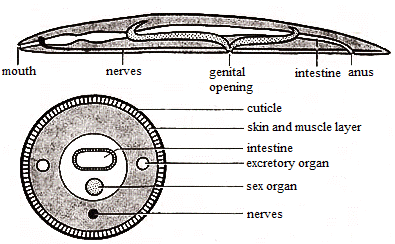
4.7 Internal body structureof Nemathelminthes (Ascaris)
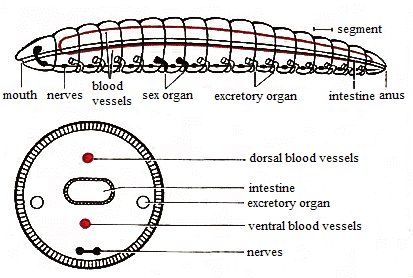
4.8 Internal body structure of the Annelida (earthworm)
1. Answer with the help of the text
1. What are metazoans? Which animal group have they developed from?
2. How are differentiated tissues developed?
3. In what environment did the simplest, first metazoans live?
4. What are the main features of the Coelenterata?
5. How is the simplest nervous system of the animals built?
6. Which groups of animals were once considered to be worms?
7. What do you call the ventral side of the bilateral-symmetrical animals?
2. Definate the following terms:
Metazoans, tribal development, individual development, bilateral-symmetrical animals, radial-symmetrical animals, sexual reproduction, fertilization, separate-sex organisms, hybrids, genitalia, reproductive cells, coelenterata, ectoderm, endoderm, cuticle, uniform segmentation, closed blood circulation.
3. Characteristics and representatives of less developed animal strains Include in a table the following characteristics of coelenterata, Plathelminthes, Nemathelminthes and Annclida:
Symmetry, segmentation, openings of the digestive tract, nervous system, blood vessel system and excretory organs
4. Also name members of these groups of animals in the table
5. Answer the following questions with the help of the table:
1. How do the coelenterata differ in symmetry from the other three animal strains?
2. How do the Annelida differ in segmentation from the other three strains?
3. In which group of animals does a bowel with mouth and anus appear for the first time?
4. How does the nervous system of the coelenterata differ from the nervous systems of the other three animal strains?
5. In which group of animals does a blood circulation occur for the first time?
6. Which animal strain does the earthworm belong to?
7. Which representatives of the Plathelminthes do you know?
8. Which representatives of Nemathelminthes are important for medicine or agriculture?
The strain with the most species is the strain of Arthropoda, which includes the class of insects other than other classes. The Arthropoda have evolved from archetypes of Annelida. The insects are the most highly developed invertebrates.
The body of the insects is unevenly segmented, in contrast to that of the Annelida, i.e. the construction of the segments is different.
The body sections head, thorax and abdomen have emerged from several segments. The insects have, like all Arthropoda clearly articulated limbs, which serve partly for locomotion and as mouthparts.
The entire body (including the limbs) is surrounded by a solid outer skeleton, which is formed by the epidermis. It consists of chitin, a nitrogen-containing polysaccharide that is very light and firm, water and gas impermeable. The chitin skeleton is composed of individual plates which are interconnected by soft membranes. The outer skeleton not only provides protection against damage, but also supports the body and provides the musculature for attachment. Besides, it protects against excessive evaporation of body fluid, first the formation of chitin enabled the Arthropoda to further develop from life in water and in moist soil to living in drier air and even to fly (the insects). The insects are well adapted to life in the dry air.
Since the solid chitin skeleton does not grow, the larvae must shed several times, i.e. leave the chitin shell and form a new, larger shell.
At the head are pair of antennas that serve as chemical sensory organs. With the large, sophisticated net eyes composed of many individual eyes, some insects can see the shapes and colors of the environment much like the vertebrates.
The three pairs of mouthparts are built differently in the various insects and thus adapted to the intake of various food. Some insects have chewing mouthparts with which they can eat plants, e.g. beetle and most larvae. Other insects feed on the juice of the flowers by means of their sucking mouthparts, e.g. butterflies. Insects with piercing-sucking mouth implants suck the blood of the vertebrates, e.g. the mosquito and other parasites.
The thorax is formed of three segments. Each segment carries a pair of legs, the second and third segments each usually a pair of wings of chitin.
The type of locomotion in the insects depends on the shape of the legs and wings. Most insects can fly, some can swim well (insects that live in the water), others can run fast (some beetles) or jump well (the flea).The abdomen also consists of several segments.
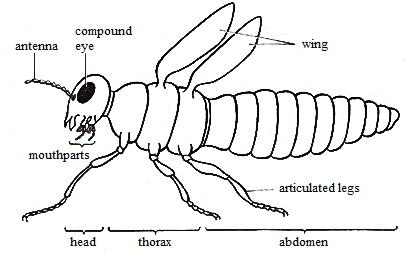
4.9 Extra construction of an insect
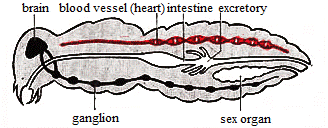
4.10 Internal construction of an insect
The highly articulated musculature of insects allows locomotion on the ground, in the ground, in the water or in the air.
The central nervous system is anterior to the annelida and has nodes connected by nerves in each segment. However, the brain is more complicated than the Annelida. It processes the excitement coming from the highly developed sensory organs (eyes, hearing organs, chemical sensory organs, etc.) and has centers that allow the insects to carry out complicated activities.
As respiratory organs serve trachea. They are tubes of chitin, which run through the whole organism and through which the air reaches all tissues directly.
They begin at the lateral openings in the chitin sheath of the thorax and abdomen and branch into the finest tubes. The gas exchange with the surrounding tissue takes place through the wall of these moist tubes.
The cycle is open and relatively easy. There is only one tubular back vessel that serves as a heart. It absorbs the blood through lateral openings and pumps it again between the tissues. The blood is not used for oxygen transport and does not look red.
The digestive canal begins in the head and ends in the abdomen. There are excretory organs connected to the digestive tract. The genitals also lie in the abdomen. Insects are separated.
1. Answer with the help of the text
1. What is the relationship between the insects and the Arthropoda? From which other group did the Arthropoda develop?
2. What do «invertebrate» animals mean?
3. What is the difference between the segments of Annelida Arthropoda?
4. Which parts of the body can be distinguished in an insect?
5. From what tissue is the cuticle created?
6. What is the substance of the insect cuticle? What properties does this substance have?
7. Justify why the larvae of insects have to skin several times.
8. How do mosquitoes feed?
9. What is the function of trachea? Describe your construction.
2. Form sentences according to one of the five examples.
Chitin: exoskeleton
Chitin: insects, protection against evaporation
Chitin skeleton: muscles, attachment
Wings: locomotion in the air
…: insects, locomotion organs
...: sensory organs for smelling
...: insects, smell
...: protective shell for the body
...: respiratory organ of insects
...: insects, respiratory system
...: insects, breathing
3. Describe the head of insect.
4. Explain what is a "closed" or an "open" blood circulation and in which animals do they occur.
5. Explain how the insects are well adapted to life in the countryside.
6. Give a talk about the outer and inner structure of insects.
Reproduction only occurs by insects sexually. Since the insects are no longer among the aquatic animals, the male gametes can not swim through the water to the female to fertilize them. Fertilization is carried out in the body of the female animal. The sexually mature, adult insects are called imago.
The development proceeds with a metamorphosis, that is, that the body shape and thus the way of life in the course of development change greatly. Two groups of insects are distinguished: insects with imperfect metamorphosis and insects with complete metamorphosis.
In the insects with imperfect metamorphosis there are the stages egg, larva, sexually mature insect. The larvae of these insects are similar to the imago in body shape, but still wingless and not capable of reproduction. But they change with every moult, so that they become even more like the imago. An example of imperfect metamorphosis is the cockroach. In insects with complete metamorphosis (e.g., butterfly) there is additionally the stage of the pupa. The larvae of these insects deviate in the body, in the color and in the food mostly completely from the adult insect and do not change even with the moulting. In the subsequent pupal stage, which looks like a state of rest, complete transformations of organs occur inside (e.g., alteration of the mouthparts and intestine, regeneration of wings). The shell of the doll is then left by the slippery insect, the imago.
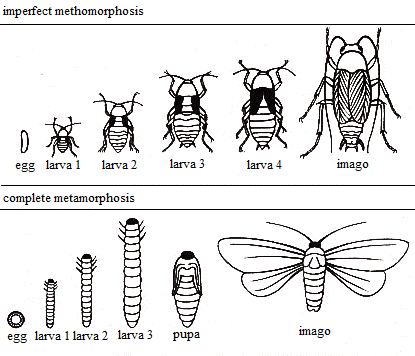
4.11 Metamorphosis of insects
For humans, the importance of the insects is extremely great, because among the many species living in all areas of the world, there are some that bring great benefits, and many that cause great harm.
Many insects, e.g. the bee, bring great benefits through the pollination of crops. These insects transfer the male cells of a plant species from flower to flower. Without them, fruit could not be found in many crops, e.g. fruit.
The honey produced by the bees and their poison are won by humans and used as food or remedy.
Many insects help by their way of life in biological pest control; they eat other, harmful insects. This activity can not be replaced by anything.In addition to beneficial insects, however, there are a large number of pests that cause great damage. Many species eat plant parts. Each crop has certain pests. In part, they also transmit plant diseases. While only the larvae appear as pests in the butterflies, the beetles can also cause great damage to the beetles.
Other insects eat human foodstuffs, destroy wood or other substances. They include: flies, cockroaches, some butterflies and beetles or their larvae.
After all, many insects are harmful to humans or animals by sucking blood and thereby transmit pathogens from disease. Examples are the mosquitoes, flies and fleas.
In order to avoid major damage, a thorough fight is necessary in all countries.
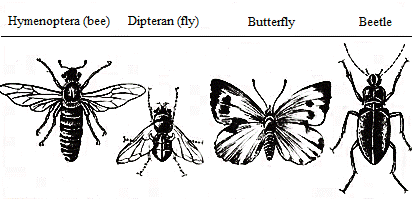
4.12 Insects with complete metamorphosis
1. Insects with imperfect metamorphosis:
e.g. Cockroaches, bugs
2. Insects with complete metamorphosis:
e.g. Beetle (protective front wings, thin rear wings for flying)
Hymenoptera (2 pairs of thin wings): bees
Butterflies (2 pairs of big wings)
Fly (only 1 pair of wings): fly, mosquitoes
1. Answer with the help of the text
1.Where does the fertilization of the eggs take place in the insects?
2. Describe the larva of an insect with imperfect metamorphosis.
3. Which four stages of development occur in insects with complete metamorphosis?
4. Why it can say that in most insects with perfect metamorphosis the pupa is a stage of external rest?
5. What are the benefits of many types of insects for plant production?
6. Which development stages of the beetles eat plants?
2. Answer the questions:
What are invertebrates?
What are wingless insects?
What are colorless wings?
What are legless larvae?
3. Define the following terms:
Abdomen, antennae, pollination, chitin, imago, larva, pupa, thorax4.
4. The importance of insects. Answer the questions:
Which insects cause damage in agriculture?
How can beetles cause damage?
Which stages of development of the butterflies cause damage?
Which worms can cause harm?
Which insects cause harm by transmitting diseases?
5. Compare the imperfect with the complete metamorphosis (Stages, comparison of the larvae with the imago).
6. Prove that the insects are more developed than the Annelida.
7. Keep structured lectures:
The importance of insects for agriculture
The importance of insects for medicine
The metamorphosis of insects
8. Take part in a discussion on the need, possibilities and limits of combating harmful insects.
In the strain of the chordata animals are summarized, which have the following characteristics:
1. You have a dorsally-lying elastic chorda of connective tissue. It is present throughout life in the case of underdeveloped chordata; in the more highly developed chordata it can only be found in the embryos because it is replaced by the spine during individual development. The chorda is the basis for the development of the inner skeleton, which is an essential feature of this strain.
2. The central nervous system of the chordata lies dorsal to the chorda.
3. Throughout life, or just embryos, there are gill slits that may have respiratory function.
4. The chordata have a closed bloodstream. The heart of the more advanced chordata is anterior. The chordata include the vertebrates. If one wants to understand the development of the vertebrates, one must deal with the lancelet. It can be called the prototype of vertebrates.
The lancet is one of the Acrania. This small group is chordata without a skull. They are still simply built. The lancet is a fish-like aquatic animal, which is only 10 cm tall. It has no bones. The chorda is maintained throughout life as a supportive organ. The central nervous system consists of only one nerve tube, which lies dorsal to the chorda. A brain is missing.
The respiratory organ is the transformed anterior portion of the intestine, the foregut, which has many gill slits. As the water flows through the gill slits, the oxygen from the water is absorbed into the blood.
A heart is missing too. The blood is moved by means of contracting blood vessels.
The excretory organs and the sexual organs are present in large numbers.
These features show the low developmental stage of the lancet eggs, which are similar to the original form of the vertebrates.
The vertebrates are divided into fish, amphibians, reptiles, birds and mammals.
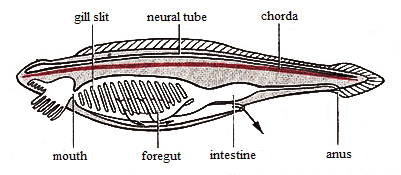
4.13 Longitudinal section through a lancet
The fish are adapted to life in the water. They are the least developed vertebrates.
The fish have a spine, a skull and ribs. During individual development, the tissue of the vertebrae grows around the nerve tube (spinal cord) and then surrounds it. The chorda is replaced.
Swimming takes place through movements of the body and fins. Fins are usually wide, bone-supported areas for swimming. They have no connections to the spine.
The fish are covered with scales and with a smooth mucous membrane. As a result, the friction is reduced when moving in the water. In fish, multi-layered epithelia occur for the first time.
As a respiratory organ fish usually have 4 pairs of gills. Gills are heavily perfused organs that are attached laterally in the oral cavity. Their surface is enlarged. Between them are the gill slits. With the help of the gills, the fish are able to absorb the oxygen dissolved in the water into the blood and release the carbon dioxide.
The blood is pumped into the systemic circulation through a very simple heart. The heart only consists of an atrium and a chamber. It pumps the blood to the gills, to 4 pairs of gill arteries. The heart contains only low-oxygen blood.
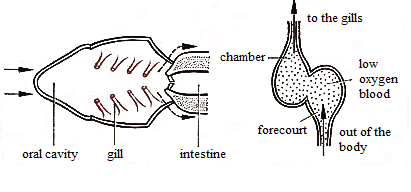
4.14 Gills and heart of the fish
The amphibians are the simplest four-legged vertebrates. The name amphibians says they can live in the water as well as in the countryside. A representative of this class is the frog. During the individual development of amphibians, larvae that live in eggs develop from eggs. They have gills and move away like fish. The blood circulation is similar to that of the fish.
During the metamorphosis, the gills recede and lungs develop. Because these lungs are still little structured, the adult animals must also breathe with their moist skin. During the metamorphosis, two pairs of limbs develop, allowing the amphibians to swim, jump or run.
As the lungs develop, so does the blood circulation. It creates the pulmonary circulation. The heart of the amphibians consists of two forecourts and a chamber. The blood entering the chamber from both atria is mixed. The arteries of the systemic circulation therefore contain no oxygen-rich, but only mixed blood.
During their individual development, the amphibians repeat the most important stages of tribal development. The archetypes of the today living four-legged land animals were aquatic animals, which were similar to the amphibian larvae. In the original forms, which began to live on the land, change the respiratory and locomotor organs.
No animal can absorb oxygen directly from the air. The oxygen must first be dissolved in water. All respiratory organs (trachea, gills, skin, lungs) are therefore covered by a thin layer of water. Because the air over the land is generally dry, the respiratory organs of land animals must be in the body to protect them from dehydration.When bodies are surrounded by water, they are sometimes worn by him. But if bodies are surrounded by air, they must lift off the ground as they move away.
The amphibians are not yet real land animals, because their skin and their eggs do not have any protection against evaporation.
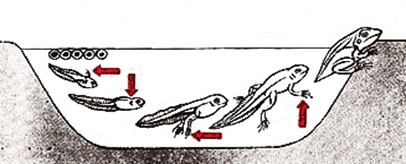
4.15. Metamorphosis of the frog
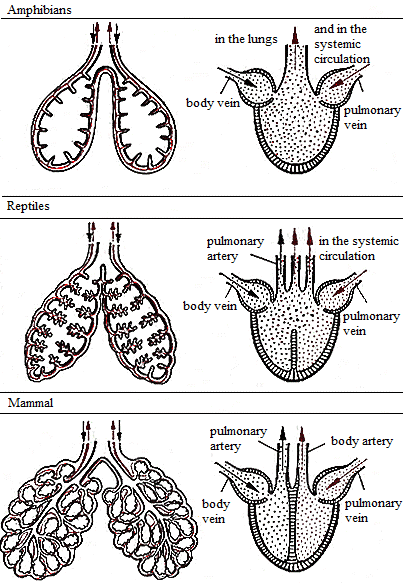
4.16 Lungs and heart of amphibians, reptiles, mammals
Most reptiles are fully adapted to life in the countryside. Only a few species (such as crocodiles) live in the water again.
The skin of the reptiles is covered with a water-impermeable layer of horn. It has the same function as the chitin of insects.
The reptiles lay eggs that are surrounded by a shell. This also protects the eggs from dehydration. These eggs must be fertilized in the female animal, however, before the shell forms. The developing embryos are protected by the shell or by the body of the female animal.
Most reptiles have two pairs of limbs (such as the crocodiles) to adapt to rural life. In other reptiles (such as the snakes) the limbs are regressed.
The lungs of the reptiles are more articulated than the lungs of the amphibians. This increase in surface area allows more gas to be exchanged.
The heart of the reptiles looks at two forecourts and two incompletely separate chambers. The blood therefore mixes much less in the heart than the blood in the heart of amphibians. The blood circulation of the reptiles is thus more efficient.
Most birds can fly. The anterior pair of limbs is reshaped into wings. Their skin is covered with feathers made of horn. There is air in the cavities of the bones and between organs. This makes the birds lighter.
Because the eggs must be protected from dehydration by a hard shell, occurs also in the birds’ indoor pollination.
The birds are descended from prototypes of reptiles.
While all the animals we know so far are grouped together as a group of animals that are warm to the cold, the birds belong to the same-warm animals. In cold-blooded animals, the body temperature depends on the temperature of the environment. The equally warm animals can regulate their body temperature to a certain value. They are thus able to be active even at low ambient temperatures.
1. Answer with the help of the text
1. What features characterize the chordata?
2. Distinguish the chorda from the spine.
3. Consider what features the vertebrates have.
4. How are the chordate divided?
5. Explain the terms individual development and tribal development. Compare the terms.
6. What causes do develop the respiratory organs of the vertebrates?
7. What does reduce friction during swimming?
8. What is the difference between gills and gill slits?
9. Why must all the respiratory organs be moist and be in the body of the land animals?
2. The development of the organs. Answer the questions:
How was the spine of the vertebrates developed?
How did the spinal cord and brain of the vertebrates look like?
How did the lungs of the vertebrates develop from?
How did the gills of the fish come from?
How have the wings of the birds developed from?
3. The situation of the organs.Use scientific location names.Use the adjectives: cranial / caudal / dorsal / ventral.
Neural tube – Chorda
Neural tube and chorda – intestine, intestine – chorda and neural tube, heart – intestine, intestine – heart, bowel – spine, spine – intestine, brain – spinal cord, abdomen – thorax, caudal spine – pelvic girdle
4. How are the insects different from the chordata in the position of the organs? (Skeleton, heart, central nervous system). First draw a simple cross section each. Use the scientific location labels.
5. Why can you call the reptiles land animals? Justify it. Break down the thoughts.
6. The fish are well adapted to life in the water. Justify this statement.
7. By anatomical peculiarities it is possible for the birds to fly. Explain that exactly.
The mammals are the most highly developed class of vertebrates. They are like the birds of simply built reptiles. They only developed to a greater extent when large areas of the earth became colder, since they were better adapted to the environment as equally warm animals than the cold-blooded reptiles.
An effective protection against the cold are the hair, which consist of horn. There is air between the hair, which conducts the heat badly and thus reduces the heat emission. The skin of the mammal is in contrast to that of the reptiles rich in glands. The mammals have sweat and mammary glands. With the help of sweat glands, the body temperature regulates itself. The evaporation of sweat is a physical process that consumes heat. The milk produced in the mammary glands of the female animals is used to feed the young animals. The boys suck the nutritious and vitamin-rich milk.
All mammals breathe through lungs, the inner surface of which is much larger than that of reptiles.
The heart of the mammals consists of two atria and two chambers. The complete separation of the oxygen-rich blood from the oxygen-poor blood, the circulation is more efficient than the reptiles. The more intense metabolism is a prerequisite for keeping the body temperature constant. The mammals have a particularly sophisticated brain.
The dentition of the mammals is differentiated, it consists of incisors, corner and molars. The shape of the dentition is adapted to the food. Herbivores have large, broad molars that allow them to chew on the plant parts. The canines are missing in most species. Carnivores, on the other hand, have highly developed canines for holding food animals and pointed molars for mincing meat and bones.
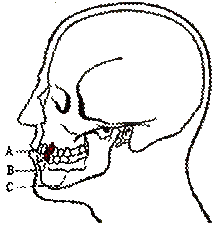
4.17 Dentition of an adult human (A – incisors, B – canines, C – molars)
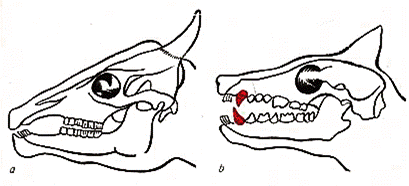
4.18 Dentition of a herbivore (a) and a carnivore (b)
The higher mammals do not lay eggs but only give birth to the young when they are well developed. The embryo develops in a special organ of the mother, the uterus. The nutrition of the embryo takes place with the help of the placenta. The placenta consists of mucous membrane of the uterus and part of the two shells of the embryo. Nutrients and oxygen enter the capillaries of the placenta with the mother's blood and penetrate into the capillaries of the embryo, which are also in the placenta. The remnants of the metabolism are transported in the reverse way from the embryo into the circulation of the mother.

4.19 Uterus with embryo
System of mammals
Class: Mammals
In addition to typical characteristics of the mammals (hair, sweat and mammary glands), some representatives also have characteristics of the reptiles (intestine, urinary and genital organs still have a common opening to the outside. The animals lay eggs.)
In some slightly more advanced mammals, the young are born alive, but are not fully developed at birth. They continue their development in a skin fold on the mother's abdomen, where they are protected and nourished.
Subclass: placental animals
The embryo is fed via the placenta in the mother's uterus. It is protected against damage of all kinds.
Order: rodents
These are herbivores with two pairs of long incisors, without canines. Many species are very harmful (rats, mice), some are used in the laboratory for experiments.
Order: predators
They are carnivores with small incisors, large corner and pointed molars.
Representative: dog
Order: Perissodactyla
These large herbivores have only one or three toes, they run on the tips of the toes. The toes have a horn hoof for protection.
Representative: the horse
Order: Cloven Hoofed Animal
These are large herbivores that run on the tips of the third and fourth toes. Many pets are cloven-hoofed animals.
Representative: the ox, the pig
Order: primates
Very sophisticated brain, very flexible limbs with five fingers or toes characterize the primates. They walk on the sole of the foot.
Representative: the monkey, the human
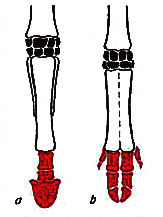
4.20 Foot skeleton of a Unpaarhufers (a) and a Paarhufers (b)
1. Answer with the help of the text
1. What features do the mammals have?
2. Why can not the oxygen-rich blood in the birds and mammals mix with the oxygen-poor blood?
3. Which types of teeth are found in mammals?
4. What is meant by the uterus ('uterus)?
5. What does the placenta (placenta) consist of?
6. What is a hoof? What function does it have?
7. What order do the dogs, the pigs, the horses, the rats or the monkeys belong to?
8. On which parts of the foot do primates, predators or ungulates run? (Primate)
2. Name the anatomical features that are the prerequisite for constant body temperature in mammals.
3. Explain the relationships between anatomical structure and constant body temperature exactly.
4. Is it an advantage if animals have a constant body temperature? Give reasons for your opinion.
5. What are the characteristics of the mammals compared to the other vertebrate classes?
6. How is the embryo protected and nourished in the mother's body? Which advantage results from this? Explain how the metabolism between mother and embryo is going on.
7. Explain the following statement: The dentition is adapted to the food of the mammals. Describe typical denture shapes and compare them.
8. The limbs of various mammalian groups are adapted to different environmental conditions.
The evolution of the tribe has been proven by many investigations of fossils and living organisms (Darwin 1809-1882, Haeckel 1834-1919) and will be further investigated.
Comparing fossil and living organisms, it can be seen:
1) an increasing differentiation of the tissues;
2) an ever more complicated construction of the organs and, consequently, an ever more specialized function;
3) increasing independence from water as an environment and better adaptation to a specific environment.
A cause of the development can be recognized in the mutations. Mutations are changes in the traits that are transmitted (inherited) during reproduction. Such a change in a feature may be of benefit to the subject, especially as environmental conditions change. When living things are better adapted to new living conditions by mutations than other creatures of the same species or other species, they remain and can reproduce more strongly than the other less well-adapted creatures. This process, which leads to increasingly better adapted to the environment forms, is referred to as selection by the environment.
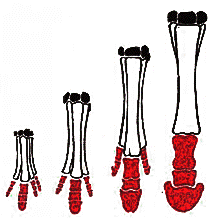
4.21 Development of the horse foot skeleton
An example of the effect of mutations and selections is the development of the horse. The only 25 cm large primeval horses lived 50 years ago in forests with soft soil. Her feet had five toes. With the wide surfaces of their feet they could walk well on soft ground. By numerous mutations emerged drcizehige, later einzehige horses. At the same time, the areas where the horses lived changed into steppes. The horses with less toes and philes were then better adapted, because they could run faster over the hard ground.
Their dentition also changed. From the teeth of the primitive horses, which ate only soft plants of the forest, developed a dentition, which could crush the hard steppe plants.
Further evidence of the evolution of the race is provided by the homologous organs. Often it can be stated that organs are homologous in different living things. Homologous organs have the same or similar internal structure because they have the same ancestry. They can be traced back to the same original form. Their external shape can be very different. This is conditioned by adaptation to different ways of life. Thus, the forelimbs of the higher vertebrates are approximately equal in their internal structure. But they serve to get around in different environments: they are used for running, swimming or flying. The forelegs of the higher vertebrates are homologous.
In similarly constructed organs with the same function one speaks of analogous organs. Their internal structure is different, since the corresponding animals are not related to each other. For example, the wings of the insects are like the wings of the birds for flying, but while the wings of the insects consist of chitin sheaths and tracheae, the wings of the birds are built up of bones, muscles, skin, feathers and etc.
In the investigation of the evolution of the stem only the homologous organs are considered. By comparing the embryos of different animals, the course of the strain development can be determined. Living beings with identical phases in embryonic development must have developed from common archetypes in the course of their evolution. In the nine months of human embryonic development, e.g. Attachments of gill slits and a tail up, and the embryo is completely covered with hair. These formations are not vital to the embryo. However, they can be used to prove that humans have emerged from animals in a very long process of development.
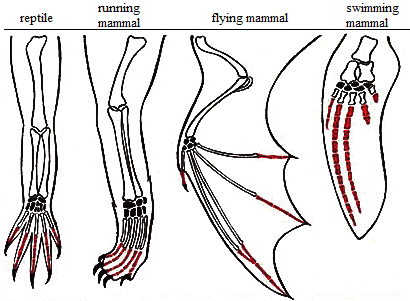
4.22 Homologous organs: forelimbs of vertebrates
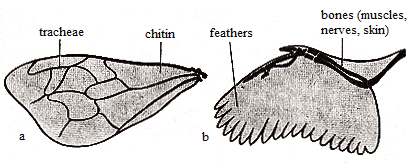
4.23 Analogous organs: wings of an insect (a) and wings of a bird (b)
Ernst Haeckel described these relationships in the "Biogenetic Principle": The embryonic development of a living being is a brief repetition of the most important stages of the evolution of the species in question.
Often formed in the living beings in the evolution of the individual organs partially back, because they had no more function, and are only present as remnants. Such remnants of regressed organs are called rudimentary organs. They show the descent of the corresponding species of such animals, in which the organs were still fully preserved and had their function. Examples of rudimentary organs in humans are the last vertebrae (caudal vertebrae) and the appendix of the cecum.
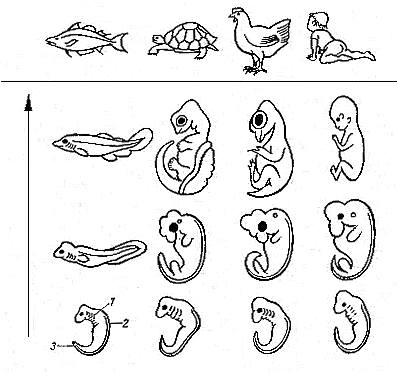
4.24 Development of embryos phase of different vertebrate classes
1 – gill slits, 2 – chorda, 3 – tail attachment
Among the fossil and the living animals, intermediate forms are to be found which combine in their physique characteristics of an older group of living beings and features of a newer group. Thus, the primitive birds still had features of reptiles (teeth, long spine in the tail, etc.), but also features of the developing birds (feathers, wings, one toe opposed to the other).
The simplest mammals still have characteristics of reptiles (eggs, not yet a constant body temperature), but also those of mammals (milk, hair). These intermediate forms show that features in development do not change all at the same time but in succession and in long times.
1. Answer with the help of the text:
1. What is proving the evolution of the tribe and exploring it more closely?
2. Which features of the development are becoming more and more obvious during the evolution of the animals?
3. What are mutations?
4. What is the result of selection by the environment?
5. In what different environment were the horses adapted in the course of their evolution?
6. Distinguish the terms homologous organs and analogous organs.
7. What does the biogenetic principle say?
8. What is meant by rudimentary organs?
9. Why is the primitive bird referred to as an intermediate form?
2. Describe the vertebrates and their organs with appropriate attributes. Use the following adjectives.
broad, thin-skinned, fins-like, five-toed, similar, nine-month-old, diverse, four-footed, aquatic.
The terrestrial vertebrate classes are ......................, and most of the time, each one of the feet is ............... .. Some mammals live in the water again. These ……………. Mammals have developed ........................ limbs. A mammal with ....................., ...................... Forelegs can fly well. While the teeth of the reptiles are not different, so ......................... there are three groups in the mammalian dentition ......................... developed by teeth. During his ........................ embryonic development, humans also have attachments of gill slits that do not take on the function of breathing.
3. Explain the evolution of the horse. Consider the influence of the environment. Is the evolution of the horse proof of the evolution of the horse? Justify your answer.
4. Explain an example of what homologous organs are and how they arise.
5. What causes analogous organs in different animal species? Are the analogous organs evidence for the theory of evolution? Give reasons for your opinion.
6. What is the significance of rudimentary organs as evidence for the development of living things?
What can be identified with the help of man's rudimentary organs about his tribal development?
7. What is the significance of intermediate forms such as the primitive bird for the study of tribal development?
8. Explain the biogenetic principle of Haeckel in the embryonic development of vertebrates.
A close comparison between the humans and the animals living today shows that humans associate with the apes, e.g. the chimpanzee, because of all primates, the great apes have the most similarities with humans (for example, construction of the skeleton, shape of hands, no tail, embryonic development, diseases, building of the body's own proteins).
However, humans are not descended from the apes living today, but apes and humans are descended from the same archetypes. This is evidenced by the hundreds of fossil skeletons and skeletons found and found in Africa, Asia and Europe. Many mutations occurred during development, and nature was affected by selections, so that today there are biological differences between humans and apes (eg shape of the spine, pelvic girdle, feet and skull, volume of aphrodisiac brain 450 cm3) the human being 1450 cm3).
The prototypes of apes and humans were small mammals 50 million years ago, living on trees and on the ground. Part of them gradually adapted more to life on trees. As a result, e.g. the shape of their feet. They developed into the apes living today. Another part adapted to life in tree-poor steppes. They lived on the ground and learned to walk upright. Their spine was doubly S-shaped curved. This was the beginning of the Incarnation.
The prehistoric people living about 3 milk years ago were able to walk upright. Since they no longer needed their hands to walk, they could do other activities with them. They began to make simple tools from objects they found in nature (stones, bones, wood). But they still had a very small brain (about 500 cm3).
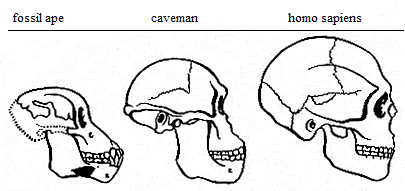
4.25 Development of the human skull
The early humans living about a million years ago already had a larger and more efficient brain (volume 1000 cm3). They were able to use stone and wood to produce various tools intended for different jobs. They started to use the fire.
Homo sapiens living today developed about 30,000 years ago.
The work with tools was the cause of brain development, for the better performance of the brain, for thinking. The common life and work was the cause of the development of languages. During the biological development of man began his social development.
Friedrich Engels wrote in 1976 in his book "Proportion of Work on the Incarnation of the Monkey" that work was the most important condition for the development of man, and that one can say that work has created man himself.
During the development of humans from the realm of animals, human society emerged. Simultaneously with the slow biological development, the rapid social development of the people is going on.
Many types of animals are divided into groups called races. In humans, too, there are various breeds that differ in appearance and morphology. All humans belong to the same kind Homo sapiens, all have the same abilities and the same rights.
1. Answer with the help of the text:
1. With which animals do humans have common prototypes? Which biological order does the human being belong to?
2. When did the archetypes of humans, primitive man, early humans live? When did the person living today develop? How long did the developmental period of the living beings last from the simplest single-celled forms to today? What do you find when comparing the times? (early – late)
3. What causes led to the development of differently constructed living beings that is also differently constructed archetypes of apes and humans?
4. What biological similarities can be found today between apes and humans?
5. What are the biological differences between humans and apes?
6. How do the found skeletons of fossil primitive humans and fossil early humans differ from the skeletons of humans living today?
7. What means: The human spine is doubly S-shaped curved?
8. What is meant by a race?
2. Indicate to which groups the human being belongs in the system of living beings and justify it (kingdom, tribe, class, subclass, order).
3. Explain how changing the way of life changed the shape of the spine.
4. Walking had consequences for the use of the hands and brain function. Explain that exactly.
5. The work was the cause of the development of thought and language. Explain that exactly.
6. The incarnation can be seen as a chain of causes and consequences.